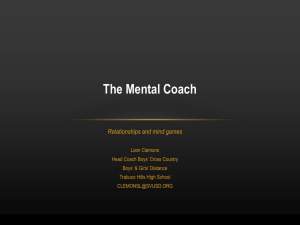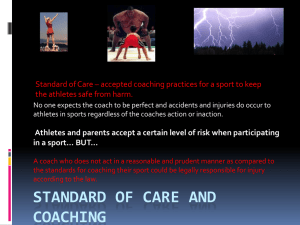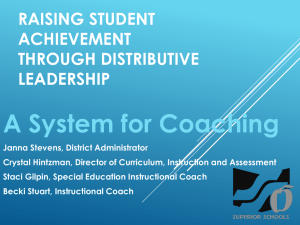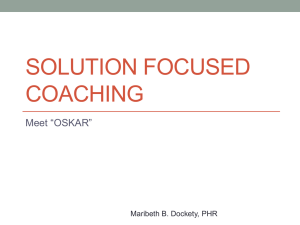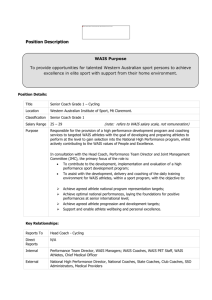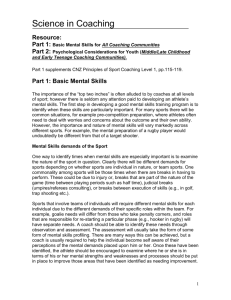Coach and Athlete Relationships (Terra Miller Lecture)
advertisement
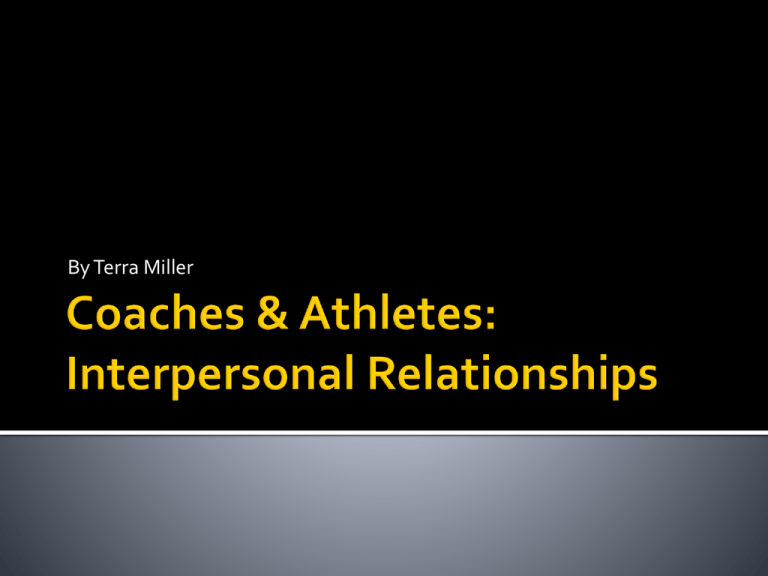
By Terra Miller What does it mean to be a coach? http://www.youtube.com/watch?v=J4zqyRSPWZk Knowledge (Werthner & Trudel, 2006) Mediated – attending clinics Unmediated – observing other coaches Internal Learning – reflecting on their experiences Other areas Undergrad degree in phys ed Knowledge from previous coaching experiences Elite experiences in competition Not all were once experts – Hitchcock, Parcells, Mourinho Based on Interdependence Theory The situation in which the coach and the athlete develop interconnected feelings, thoughts and behaviors Collaborative Relationship Collaborate – to work with another or others on a joint project Aspects of a collaborative relationship: Neither participant taking a superior role A ‘team’ approach Joint efforts Both being open and explicit The coach’s collaborative stance and demeanor The coach providing rationales The coach offering techniques which the athlete can choose whether or not to use The coach admitting mistakes Collaborative spirit More successful together instead of separately Ex: Clyde Hart & Michael Johnson (Track), Bob Bowman & Michael Phelps (Swimming), Mary Lou Retton & Bela Karolyi (Gymnastics) Process Vehicle Coach’s Role – directing, instructing, supervising, monitoring, training, performance, learning and development Deals with intrapersonal, interpersonal and contextual factors Enhances people’s capacity to achieve a goal or develop a specific skill Work together with athletes in an effort to facilitate continuous skill development, maintain high levels of enthusiasm and ultimately achieve performance success Closeness Reflects affective ties and includes interpersonal liking, trust, respect and appreciation Ex: The athlete needs to trust their coach to have a certain degree of closeness that binds the relationship Commitment Ties that are long term Ex: Maintaining a relationship through the good and the bad Complementarity Cooperative interactions Ex: Understand that the coach is the dominant authority and the athlete is the submissive 1C = Co-orientation Interdependence that exists in interpersonal relationships Ex: The athlete can easily interpret each direction given by the coach Passion for the sport Team cohesion and coach leadership Coach-created motivational climate Achievement motivation Satisfaction with sport Relationship satisfaction Conflict and support Empathic accuracy Physical self-concept Collective efficacy Attachment orientations Teaching principles – being able to instruct Can communicate about issues outside competition Co-orientation - interdepence Closeness – to develop the relationship Confidence – being able to positively approach teaching Positive Democratic style of decision-making Social support and praise ▪ Satisfaction of athletes with coach, increased sport enjoyment, selfesteem, more effort and success Negative High levels of criticism Low levels of positive reinforcement ▪ Decrease perceived confidence in athletes Strong relationship between athletes’ liking of their coaches, and their perceptions of the ability of their coaches ***Is there anyone who disagrees?*** Six Common Characteristics of Critical Moments 1. Intense emotions for the athlete. 2. Intense emotions for the coach. 3. A tension in the relationship between the coach and the athlete. 4. A tension around the boundary of the coaching relationship. 5. Unexpected and unforeseen. 6. A qualitative change in the nature of the coaching relationship. Recognize when something is wrong Important to focus on goals, but also keep a strong focus on the relationship Working through conflict allows for the coach and athlete to see strength of relationship Both should know the value of the relationship and what they can do for each other All relationships go through rocky times Carter, A. D., & Bloom, G. A. (2009). Coaching knowledge and success: Going beyond athletic experiences. Journal of Sport Behavior, 32, 419-437. Day, A., De Haan, E., Sills, C., Bertie, C., & Blass, E. (2008). Coaches’ experience of critical moments in the coaching. International Coaching Psychology Review, 3, 207-218. Donahue, B., Miller, A., Crammer, L., & Cross, C. (2007). A standardized method of assessing sport specific problems in the relationships of athletes with their coaches, teammates, family, and peers. Journal of Sport Behavior, 30, 375-397. Jowett, S. (2009). Validating coach-athlete relationship measures with the nomological network. Measurement in Physical Education and Exercise Science, 13, 32-51. Jowett, S., O’Broin, A., & Palmer, S. (2010). On understanding the role and significance of a key twoperson relationship in sport and executive coaching. Sport & Exercise Psychology Review, 6, 19-30. Oberstein, S. (2010). Capitalizing on coaching challenges. T & D, 64, 54-57. O’Broin, A., & Palmer, S. (2009). Co-creating an optimal coaching alliance: A cognitive behaioural coaching perspective. International Coaching Psychology Review, 4, 184-194. Sanchez, J. M., Borras, P. J., Leite, N., Battaglia, O., & Lorenzo, A. (2009). The coach-athlete relationship in basketball: Analysis of the antecedents, components and outcomes. Revista de Psicologia del Deporte, 18, 349-352.


